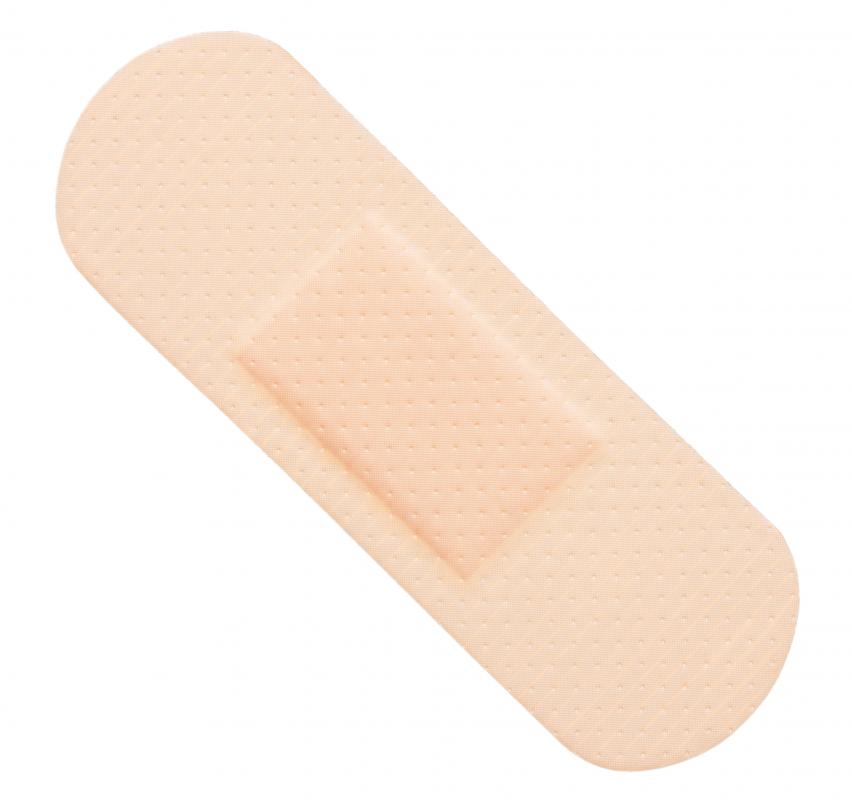At WiseGEEK, we're committed to delivering accurate, trustworthy information. Our expert-authored content is rigorously fact-checked and sourced from credible authorities. Discover how we uphold the highest standards in providing you with reliable knowledge.
What Should be in an Office First Aid Kit?
Office environments do not usually engender serious accidents, so stocking an office first aid kit is not difficult. When stocking a first aid kit for the office, concentrate on what people are going to need most often. Office injuries are usually minor, including paper cuts, steam burns from the microwave, an occasional scalding from the office coffee pot and the like. What will be needed most often are over-the-counter medications and small personal grooming instruments such as tweezers.
Medical items in the first aid kit should include: latex-free adhesive bandages in various sizes, antibiotic ointment, isopropyl alcohol, hydrogen peroxide, cotton swabs, cotton balls, instant hot and cold packs, burn cream, an elastic bandage, scissors and adhesive tape. A pair of latex-free surgical gloves can be included, but chances are, if these are needed, a coworker should call 911. Also include a booklet on first aid. This can be obtained from the American Red Cross.

Medicines in the first aid kit should include a variety of over-the-counter pain relievers. Include a bottle of old-fashioned aspirin, but make sure the pills are coated for ease of swallowing. Other pain relievers in the first aid kit should include acetaminophen and ibuprofen, all in an easily-swallowed form, as well as non-drowsy sinus medication. Also drop in a package of throat lozenges, a bottle of antacids and a box of effervescent pain reliever/antacid.

In the “implements” category for the first aid kit, include tweezers, safety pins and an eyeglasses repair kit. Also, include anything in the first aid kit that might increase employees’ comfort and well-being. Small sewing kits are popular, and the needles may be useful for other first aid applications. A separate box containing tampons and pantyliners can be kept for the female employees. It’s always a good idea to keep a box of facial tissues or a roll of toilet paper handy, in case the custodians forget to stock the bathrooms.

Serious incidents in an office building are most likely to be something like a heart attack or stroke. Because of this, employers should have at least one person in each department trained to administer cardiopulmonary resuscitation (CPR). Many companies now offer on-site Automated External Defibrillator (AED) machines as well. The Red Cross offers training, and it is a worthwhile investment for any company, especially if an employee’s life can be saved because a co-worker knows CPR or other emergency procedures.

Another idea gaining popularity has employees making a record of their medical history. This information is kept in the employees’ desks or confidentially filed with the personnel or human resources manager. Employees list any medical conditions, prescription medications and allergies, and this list can be given to emergency medical technicians (EMTs) if the employee requires an ambulance. Having this record at hand gives the EMTs valuable information about a patient and allows them to treat him or her with greater accuracy, as well as giving the emergency room doctor a heads-up on any medical conditions, such as diabetes, that might affect emergency treatment at the hospital. It must be understood that these records are completely confidential and not to be used for any reason other than the employee’s emergency care by an EMT.
Employers need to remember that when their company shows caring, even with such a small gesture as a well-stocked first aid kit, their workers are likely to be happier and more productive.
AS FEATURED ON:
AS FEATURED ON:
























Discussion Comments
Amen!
Due to the number of allergies present in persons and medical contradictions even with OTC if a person is taking prescriptions (some which they may not know) OTC medication should *never never never* be dispensed from an office kit by non medical personnel. The liability is very high for any office that does this. OTC medications should only be self provided and not provided by the "official office."
Post your comments